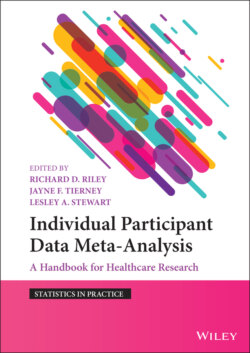Читать книгу Individual Participant Data Meta-Analysis - Группа авторов - Страница 95
4.6.3 Missing Outcome Data
ОглавлениеIf participants drop out or are actively excluded from the analysis of a trial in substantial numbers and/or disproportionately by group, this could lead to quite considerable imbalances between intervention and control groups. More importantly, it could lead to incomplete outcome data and potentially attrition bias. For example, an examination of 14 cancer IPD meta‐analyses, incorporating 133 trials, found that between 0% and 38% of randomised participants were excluded from the original trial survival analyses, with the largest proportion often being excluded from the treatment groups (Figure 4.11). In one of these projects examining the effects of chemotherapy for soft tissue sarcoma,112 the evidence for a benefit of chemotherapy on survival was stronger when it was based just on participants included in the original trial analyses (hazard ratio = 0.85; 95% CI: 0.72 to 1.00, p = 0.06), compared to when all possible participants were included (hazard ratio = 0.90, 95% CI: 0.77 to 1.04, p = 0.16).
Figure 4.11 Percentage of participants excluded from the original analyses of trials included in 14 IPD meta‐analysis projects in the cancer field.112
Source: Jayne Tierney, reproduced with permission from Tierney and Stewart.112
Therefore, it is important to check that data on all, or as many as possible, participants recruited to a trial are included in an IPD meta‐analysis (assuming that all the individuals meet the IPD meta‐analysis inclusion criteria for population and setting). If good records are maintained for a trial, it is possible to recover data on participants who were excluded from the original trial analyses, as part of the IPD collection process, and incorporate them into the meta‐analysis. For example, in the same 14 cancer meta‐analyses described previously, when IPD were collected, approximately 1,800 participants who had been excluded from the original trial analyses were re‐instated, and without them most meta‐analysis results would have been biased towards the research intervention, albeit to a small degree in most cases.112
A major advantage of IPD meta‐analysis is the ability to include all outcomes of relevance to the meta‐analysis, irrespective of whether they have been published or not, thereby overcoming the potential biases associated with differential reporting of outcomes,113 and providing a more balanced view of benefits and harms. For example, in a systematic review of laparoscopic versus open surgery for the repair of inguinal hernia, based on the available published aggregate data from three trials, the risk of persistent pain was found to be significantly greater with laparoscopic repair (odds ratio = 2·03, 95% CI: 1·03 to 4·01).114 However, when IPD were collected, data were available for a further 17 trials that had not published results for this outcome, and the combined meta‐analysis results showed that the risk of persistent pain was actually lower with laparoscopic repair (odds ratio = 0·54, 95% CI: 0·46 to 0·64). Recognising that some outcomes measured in trials may not be reported, it is always worth checking trial protocols, registry entries and with trial investigators to firmly establish which outcomes can be made available when IPD are provided.115
